Quick Start
The following is intended to be a quick start for those already familiar with data retention concepts and who are looking to deploy Content Retention Manager for Confluence.
We strongly recommend trying our app out first on a development, test, or staging tenant in order to familiarize yourself with it’s features and capabilities. This will help make sure the app conforms to your policies and expectations.
Review prerequisites
A defined company policy on data retention or information governance. You’ll use this to define the policies, classifications, and rules within Content Retention Manager for Confluence.
An active Confluence Cloud instance.
A user account with Confluence Admin (Site-Admin) privileges.
Installation and first use
Install Content Retention Manager for Confluence from Atlassian Marketplace into your instance.
Once installation completes, select Confluence administration tools (
in the top right menu bar)
On the left navigation menu, scroll down to
Apps, and select Content Retention Manager for Confluence
Dashboard
The Dashboard provides a visual summary of your content retention status in Confluence. It helps administrators quickly assess retention coverage, policy distribution, classification levels, and upcoming expiration trends.
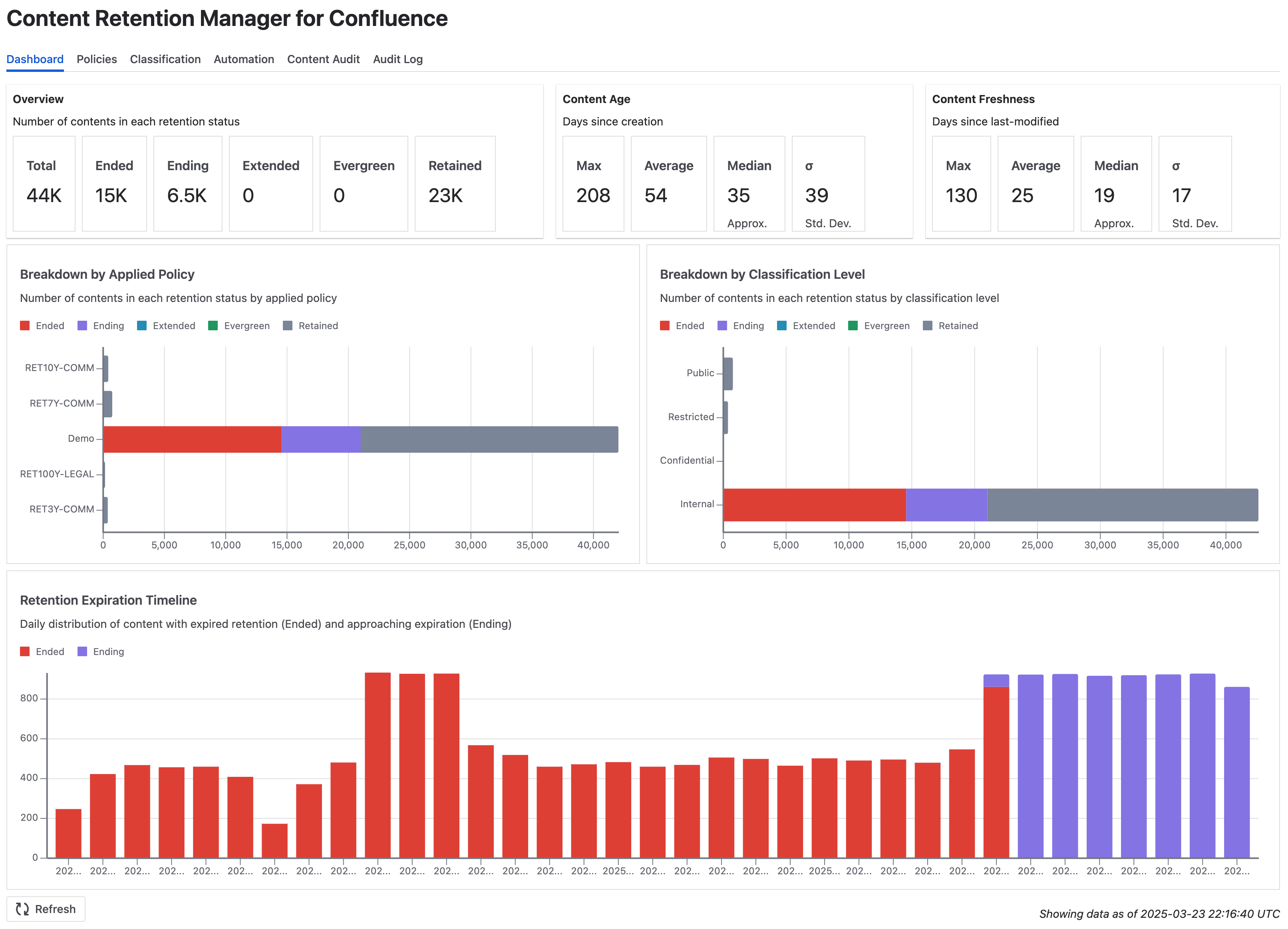
Dashboard tab in Content Retention Manager for Confluence
Retention Statuses
Each content has one of the following retention statuses:
Retention Status | Definition | Visibility / Discovery |
|---|---|---|
RETAINED | Content is in an active state and available. This means it hasn't expired per your policy or any extensions. | Accessible / Discoverable |
EXTENDED | Content in which an admin has granted a specific retention policy that can either be shorter or longer than the company's global retention period. | Accessible / Discoverable |
EVERGREEN | Content in which an admin has extended the retention policy indefinitely. This content will never expire or be automatically removed. | Accessible / Discoverable |
ENDING | Content is nearing end of your retention period and you should determine if it needs to be granted an extension or if it's ok to be removed. | Accessible / Discoverable |
ENDED | Content has expired against your defined retention policy. When a retention period of content ends, the content is first Deleted (recoverable) then Purged (irrecoverable) after a defined period of time in your Policies. | Deleted / Purged |
Dashboard Insights
When you first visit the dashboard right after installation, it's likely that the app has not scanned the content in the background yet. In this case, you'll be prompted to refresh the stats by clicking the Refresh button. The initial stats will be using the default policy settings. You can always manually refresh the stats on Dashboard after you've made changes to the policies (please refer to the Setting up your Retention Policies).
On the Dashboard, there are a few tiles providing high-level stats for the content:
Overview: The total number of contents found on the Confluence site, as well as the number of contents in each retention status
Content Age: Time since content creation (Max, Average, Median, Standard Deviation).
Content Freshness: Time since last modification (Max, Average, Median, Standard Deviation).
Furthermore, three charts are provided for insights on the breakdowns:
Breakdown by Applied Policy: This chart shows content grouped by applied retention policies (e.g., RET10Y-COMM, Demo) and color-coded by retention status (Ended, Ending, Retained, etc.). It gives a quick view of how policies are being applied and which ones have the most expired or active content.
Breakdown by Classification Level: This chart organizes content by classification level (e.g., Internal, Confidential, Restricted, Public) and highlights the retention status of each group. It's especially useful for verifying retention compliance for sensitive content.
Retention Expiration Timeline: This timeline chart shows the number of content items whose retention:
Has expired (red), or
Is approaching expiration (purple)
It provides a daily breakdown so you can monitor upcoming retention events and plan follow-up actions.
Dashboard data is typically updated on a daily schedule through an automatic scan of all contents. For up-to-the-minute insights, you can click the Refresh button at the bottom left to trigger a manual scan. The timestamp at the bottom right shows when the most recent data snapshot was taken.
Setting up your Retention Policies
Leave Automation turned off for now. We’ll enable that later.
It is advisable to audit your content after setting the retention policies. Enabling automation at this stage may result in the deletion and potential irreversible purging of expired content from your instance. Keep in mind the primary objective of this application is to assist with data compliance.
Retention Policies are the primary dimension by which you can gain insights into and manage your content in Confluence. As an admin, you can define multiple Policies, assign a global default retention policy, and assign a different policy with Space, User, and Classification Level Retention Rules. Once your Retention Policies are in place you can scan and report on all content in Confluence. When you’re confident the policies are accurate, you can optionally enable automation to securely dispose of old content that is beyond it’s applicable policy.
Select the
Policiestab. This is where you will set your team's defined retention policy in days, and designate any granular entity-specific retention policies.
Feature | Definition |
|---|---|
Default Retention | Where you select your site-wide retention policy. This will be your global default across all spaces. |
Retention Rules | Where you can set custom retention policies for specific entities, such as spaces or users. Tip: with a User rule, you can effect a discovery hold for content Created by or Modified by that User. |
Policies | Where you create your custom content retention policies to be set against projects or your global default. The days you set will help the audit tool flag all content that is nearing the end of the retention period or has expired past the retention policy. When automation is enabled, Retention Manager will purge content from Confluence according to these policies. |
Create a custom policy in Policies if you don't see a preset policy that matches your desired retention schedule. Refer to the Adding a Policy step below. Each policy has a defined retention period and a warning period. The warning period happens at the set number of days before expiration to notify users and admins of the upcoming content removal. This will help your team keep an eye on content expiring before they expire and request content to be excepted against the policy. Extensions can be granted manually on the Content Audit tab.
Be sure to click Save to apply your changes to the Policies settings. The changes will only take effect after they are saved.
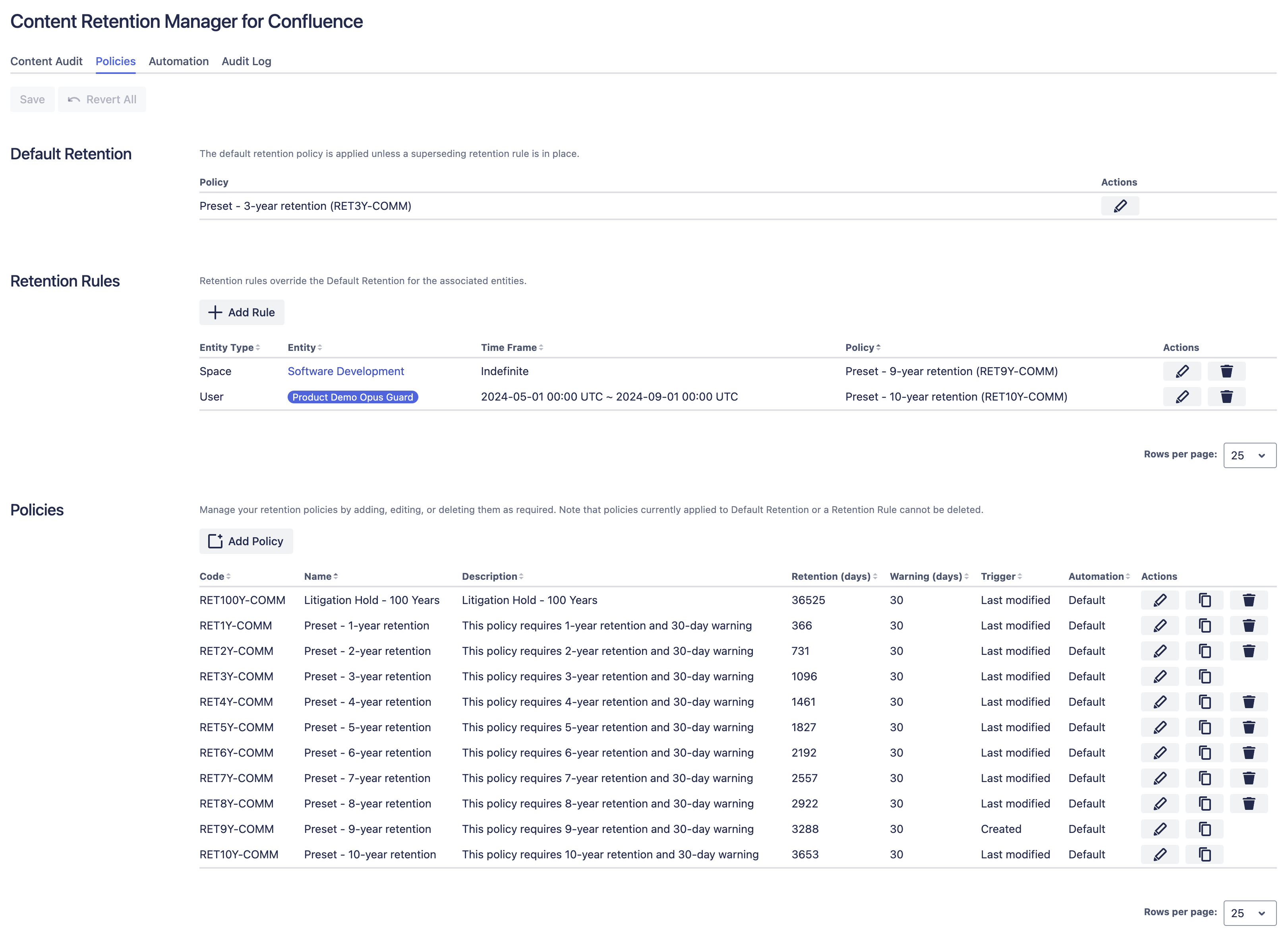
Policies tab in Content Retention Manager for Confluence
Adding a Policy
Click the Add Policy button in the Policies section to create a new policy.
In the Add Policy dialog, start by entering a unique identifier in the Code field to distinguish the policy being created. Next, provide a clear and descriptive name in the Name field. In the Description field, outline the purpose and scope of the policy to ensure its intent is easily understood.
In the Trigger dropdown, select when the retention period should begin, such as when the content was last modified or created. Specify the duration for which the content should be retained in the Retention (days) field.
Additionally, in the Warning (days) field, enter the number of days before the retention period ends to mark the content as ending retention status as a warning.
Finally, select the appropriate Automation setting, choosing between applying the global automation settings (Default) or disabling automation for this policy (Disabled).
Once all the fields are filled out, click Apply to add the policy.
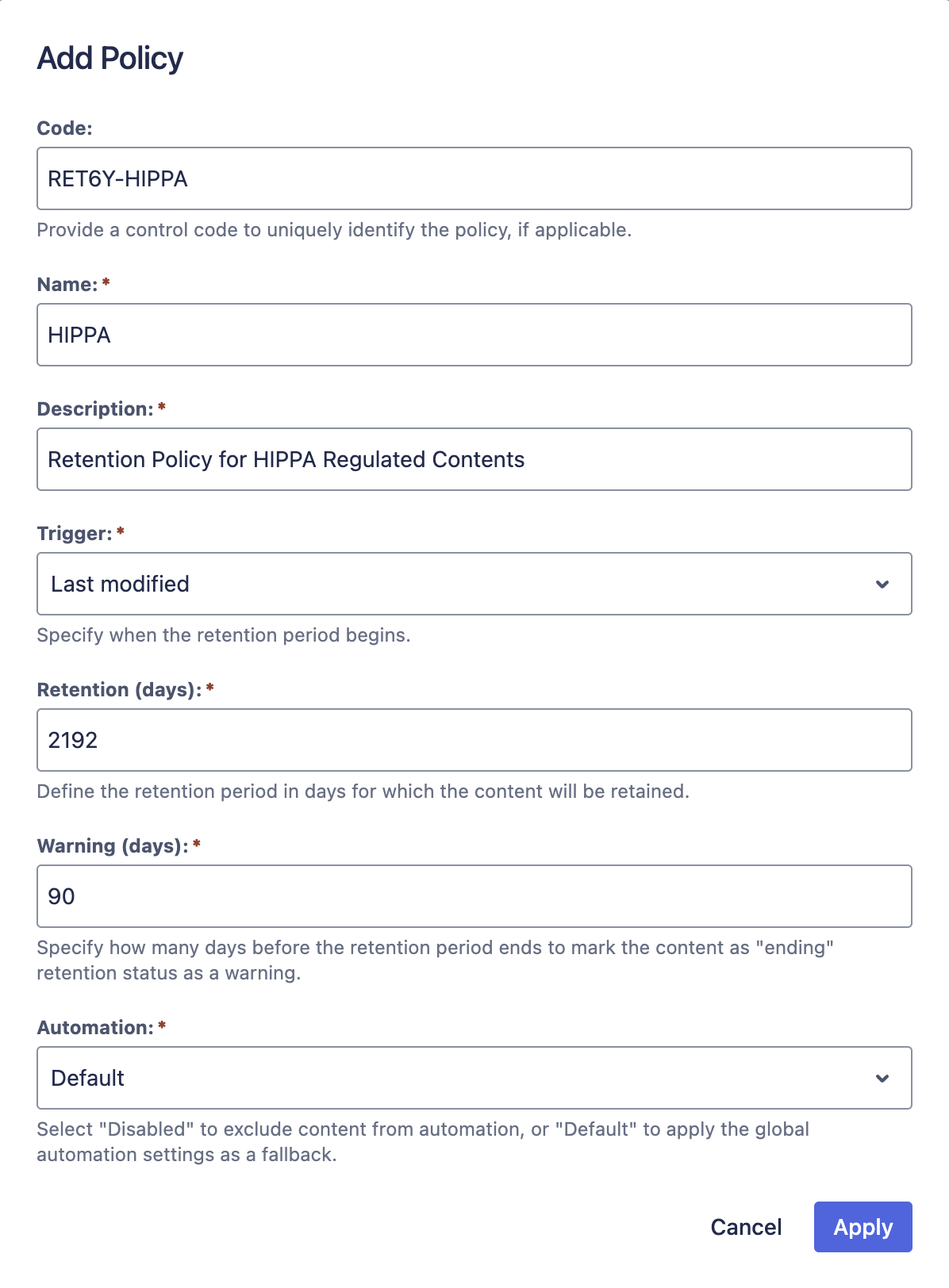
Example Policy Settings
Adding a Rule
Click the Add Rule button in the Retention Rules section to create a new rule.
In the Add Rule dialog, first select the entity type for which you want to create the rule. For example, if you select User as entity type, you can then search for the user by their names and select a user for the rule.
In the Policy Definition dropdown, specify the retention policy for the selected user. This policy will override the default retention policy for contents created or last-modified by the user.
Optionally, you can select a time frame to limit what contents the rule applies to. Toggle the Apply to a time frame switch and specify the start and end dates.
Click Apply to add the user rule.
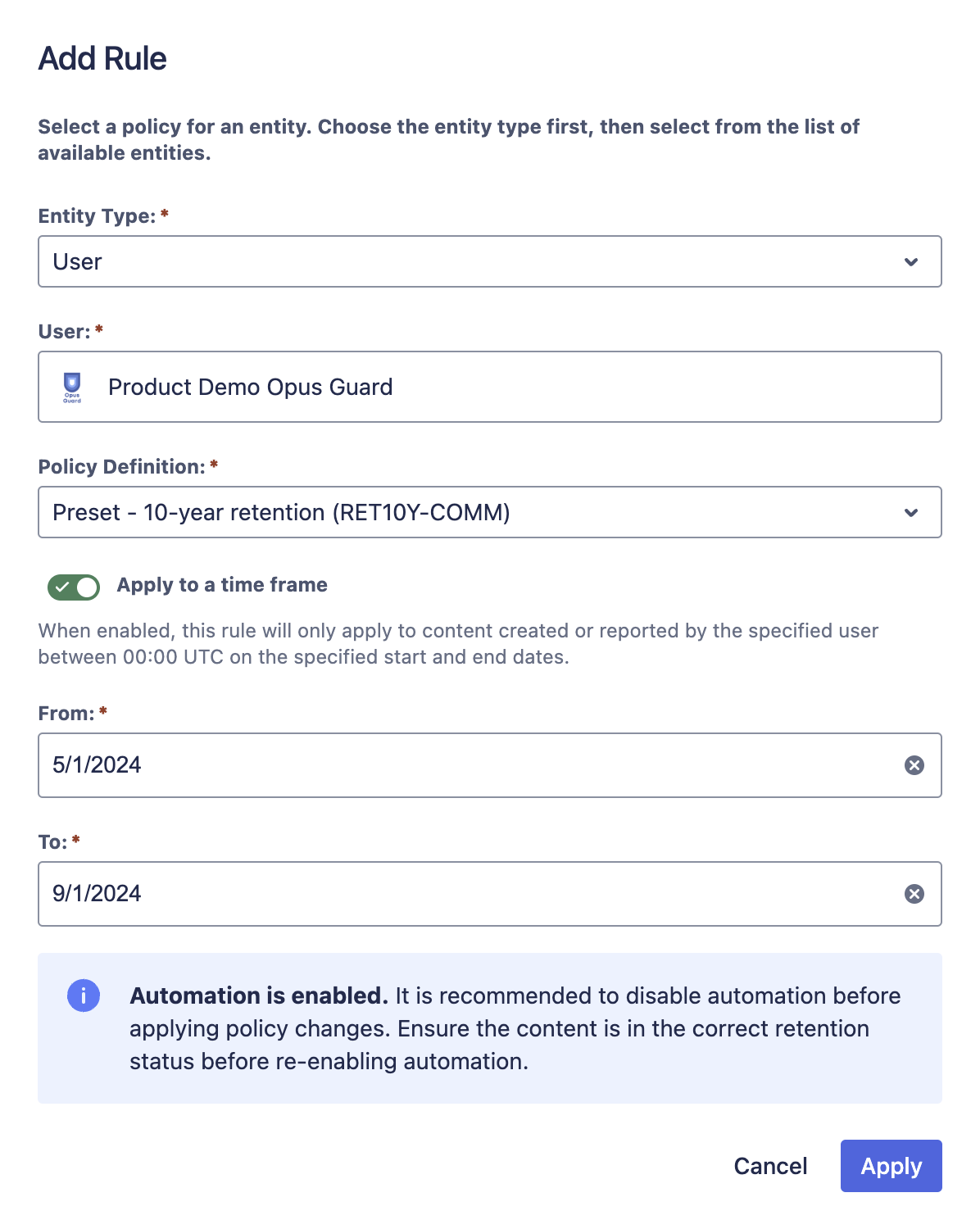
Example User Retention Rule Settings
If you have defined Classification Levels (refer to Setting up your Classification Levels below), you can also select Classification level entity type and add a rule for a specific classification, as shown below.
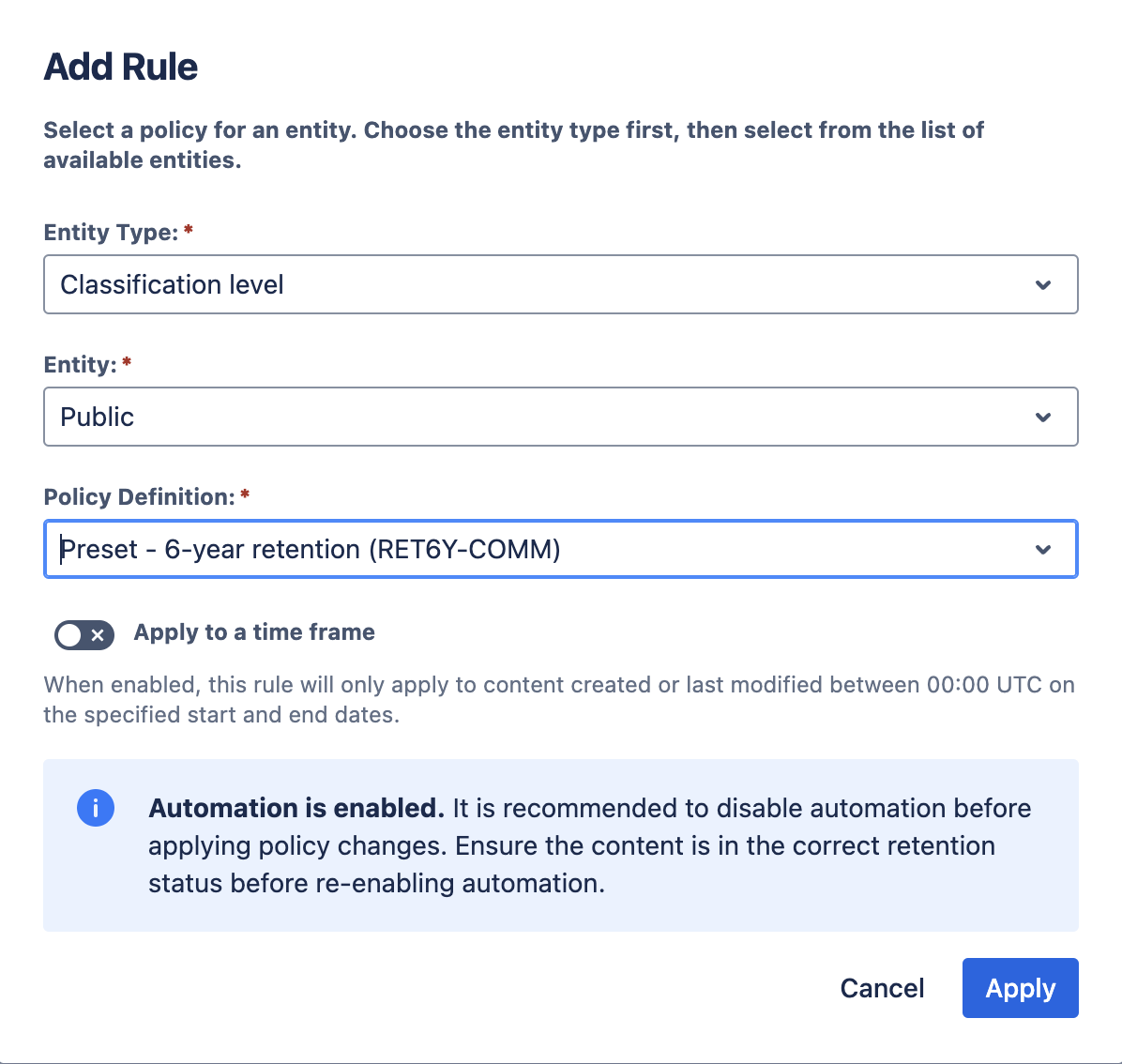
Example Classification Level Retention Rule settings
You can also select Space entity type and add a rule for a specific space, as shown below.
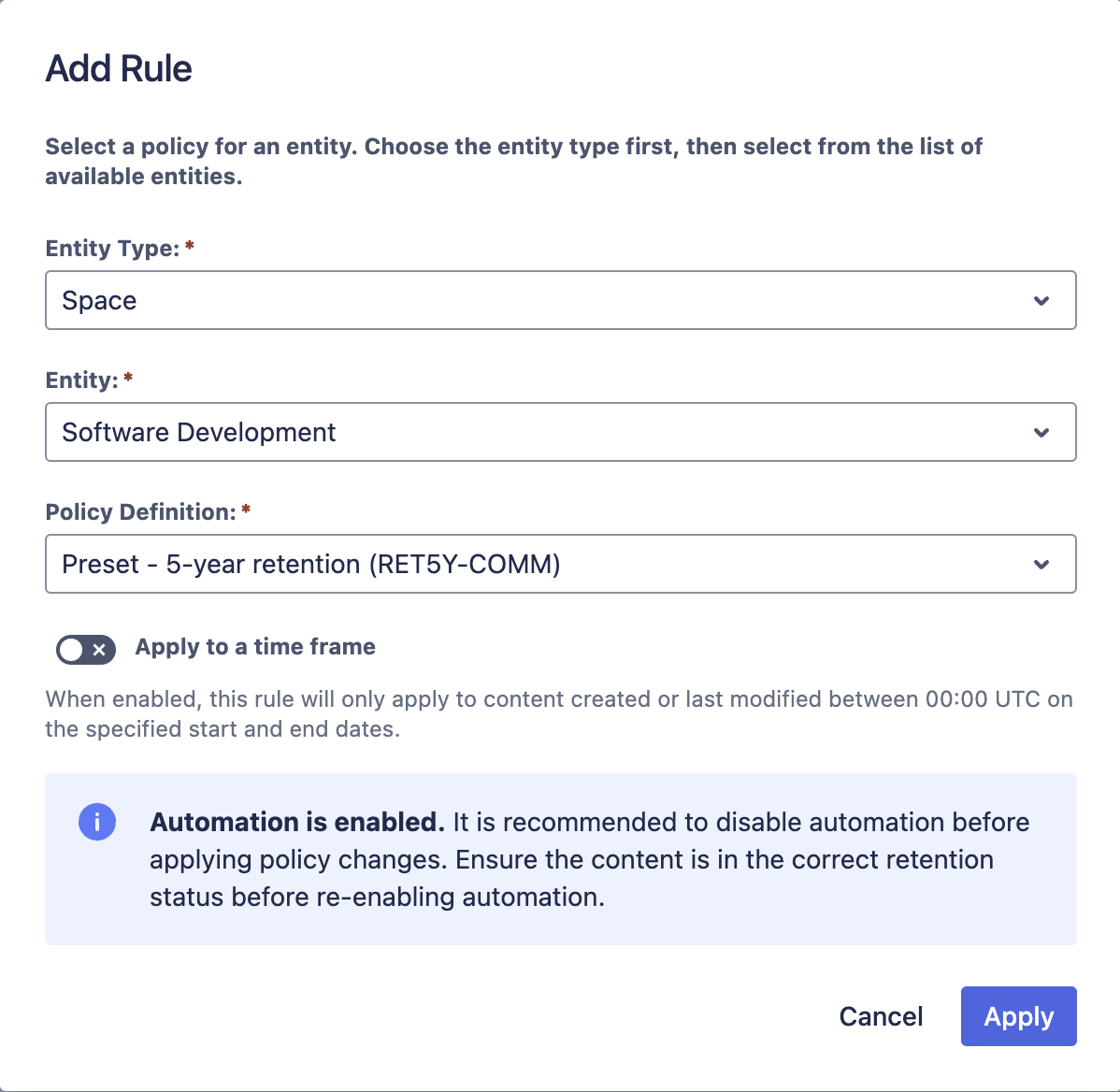
Example Space Retention Rule Settings
If content matches multiple Rules, the following override order will apply:
User entity type Rules take precedence over all others, then
Classification entity type Rules take precedence over Space Rules, then
Space entity type Rules will take precedence
If no Rules match, global default Retention will apply
When content matches multiple user-based rules, the rule for the user who last modified the content takes priority over the rule for the user who created it.
By following these steps, you can customize your retention policies to fit the specific needs of your team and organization. Remember, auditing your content first ensures that you can review and adjust these policies before any automated actions take place.
Setting up your Classification Levels
Classification provides another dimension to manage and categorize your content in Confluence. As an admin, you can define multiple Classification Levels, assign a global default Classification Level, and assign a default Classification Level to any space. As a user, you can specify a classification level to each piece of content to override the space and the global default classifications, as long as you have edit permission to that content.
Select the
Classificationtab. This is where you will set a default classification level to apply to any content that is not specifically classified differently, and where you will set all Classification level definitions and the order of their sensitivity.
Feature | Definition |
|---|---|
Default Classification | Where you select your site-wide classification level. This will be your global default across all spaces. |
Classification Level | Where you create your custom classification levels to be set against pages and posts, spaces, and your global default. The order of the Rank indicates a sensitivity level, and Classifications will be presented in rank order to users when selecting a new level on a piece of content. |
Create a new Classification Level if you don’t see a preset level that matches your organization’s needs. Refer to the Adding a Classification Level section below. Each Classification Level has a name, a description, and a color for display along with a rank to help communicate the sensitivity of the level to a user.
Be sure to click Save to apply your changes to the Classification settings. The changes will only take effect after they are saved.
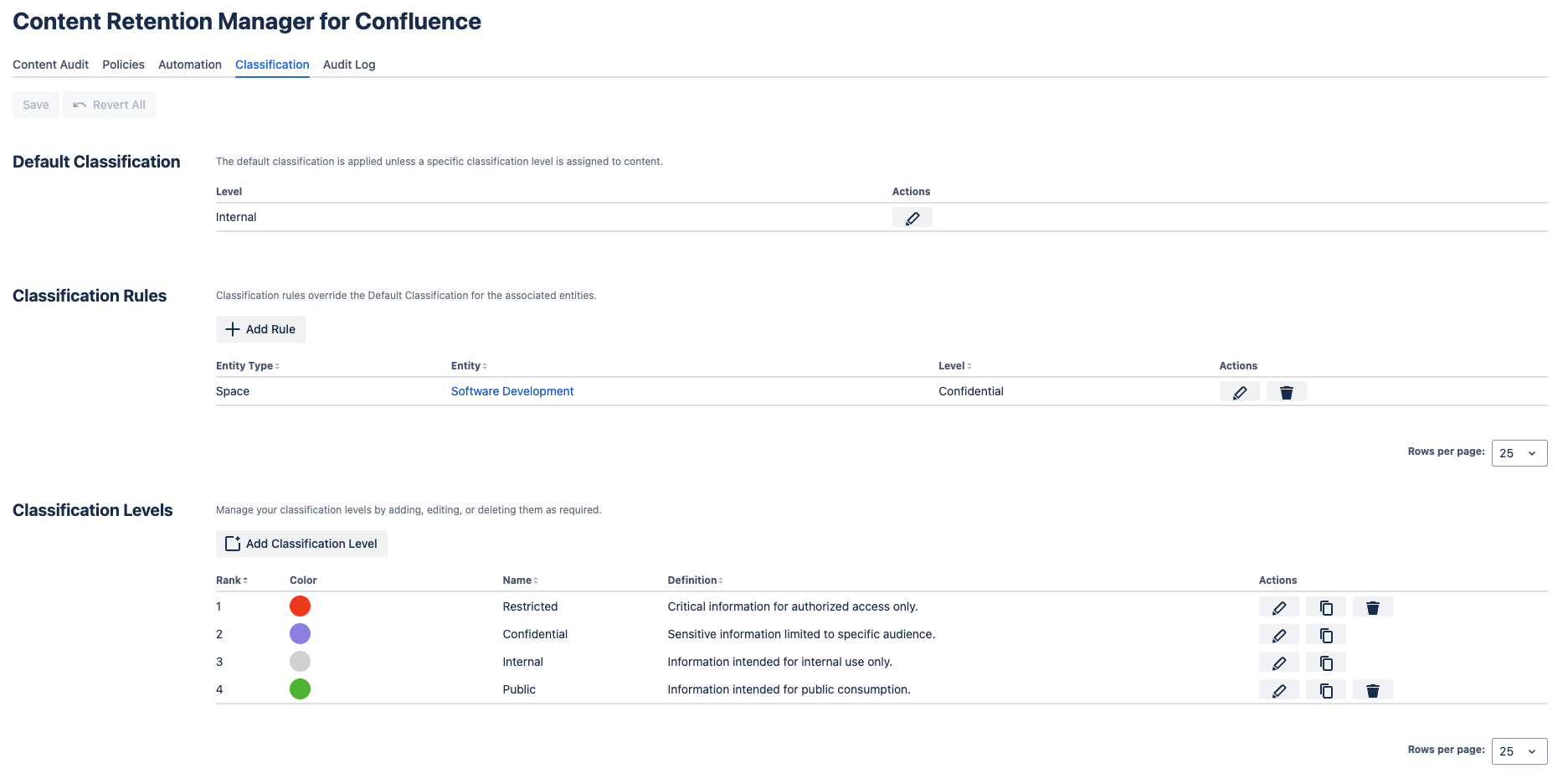
Classification tab in Content Retention Manager for Confluence
Adding a Classification Level
Click the Add Classification Level button in the Classification section to create a new classification level.
In the Add Classification Level dialog, start by entering a unique and descriptive name for the new level. In the Description field, outline the purpose and scope of the classification to ensure its intent is easily understood.
Choose a Color to display alongside the classification to help convey its sensitivity when it is applied to content.
Finally, choose a Rank for the classification level to help convey its sensitivity to your users. If you choose a Rank that is already in use by another classification level, they will then be displayed in order seen in the Classification tab. You can choose unique ranks for each level.
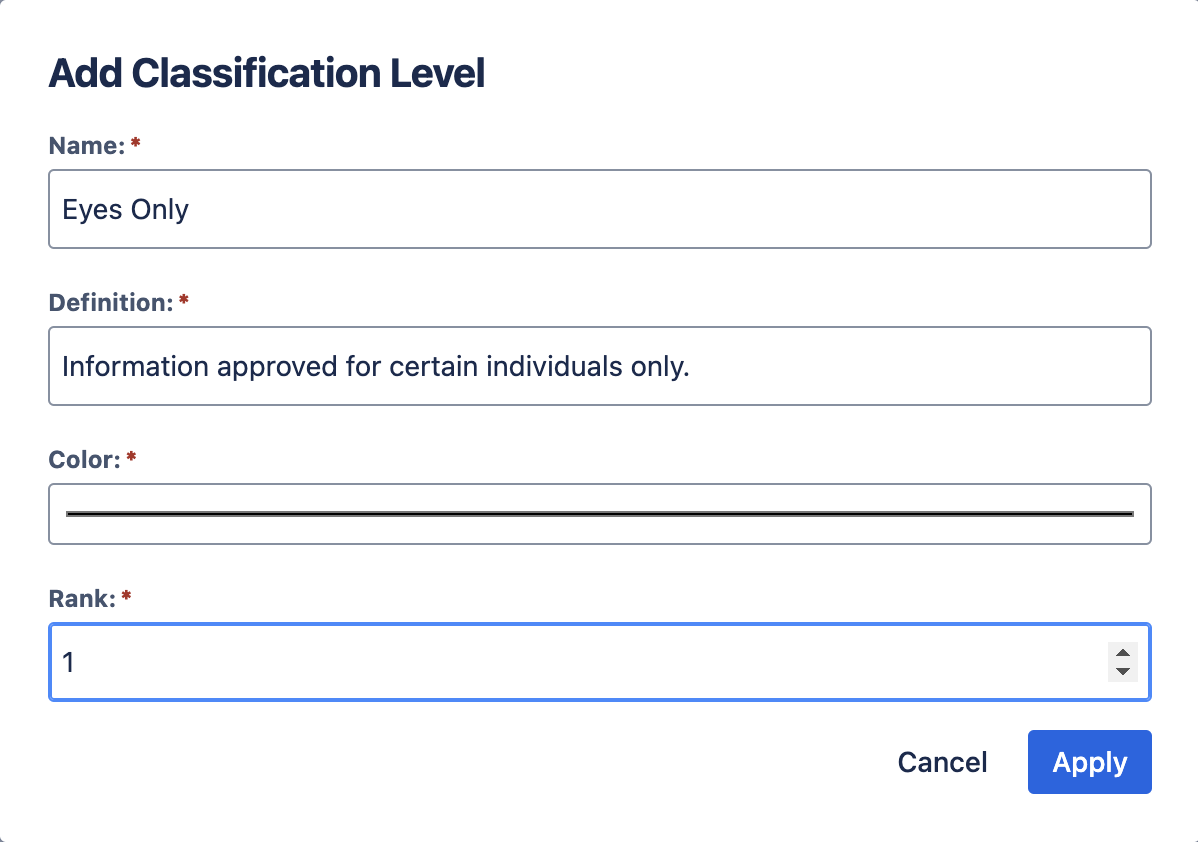
Example adding of a Classification Level
Adding a Classification Rule
Click the Add Rule button in the Classification Rules section to create a new rule.
In the Add Rule dialog, first select the entity type for which you want to create the rule. For example, if you select Space as entity type, you can then search for the spaces by their names and select a space for the rule.
In the Classification Level dropdown, specify the classification level for the selected space. This policy will override the default classification for contents in the selected space.
Click Apply to add the space rule.
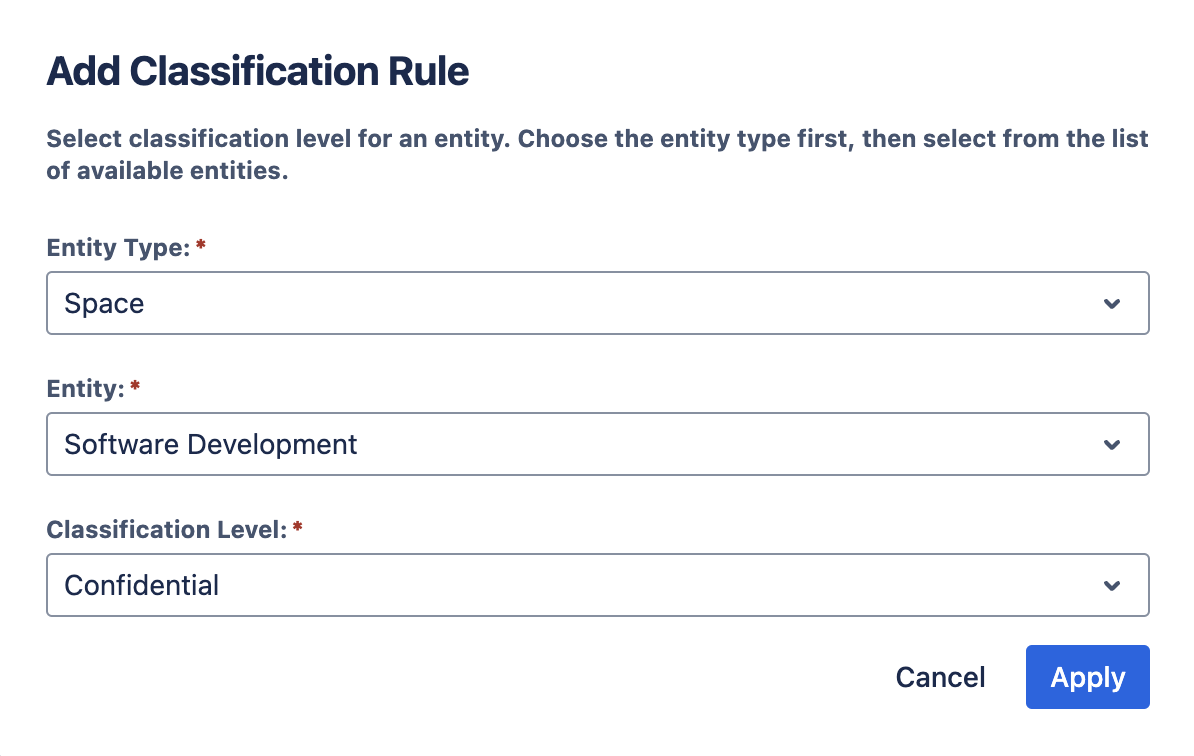
Adding a Classification Rule to a Space
Classification Level visibility and management
This feature is not available in Lite edition of the app.
When a user views a page or blogpost, Content Retention Manager for Confluence will display the current effective Classification Level in a byline item alongside the metadata.

Example of a Classification Level display on a page
The byline clearly shows the current Classification Level, providing users with quick and easy access to classification details. Users with Edit permission to the content can update the Classification Level by:
Clicking the current Classification Level in the byline.
Selecting a new level from the dropdown menu.
Using the search field to quickly filter and locate the desired Classification Level by typing part or all of its name.
Once a new Classification Level is selected and the dialog is closed, the updated level is immediately reflected in the byline.
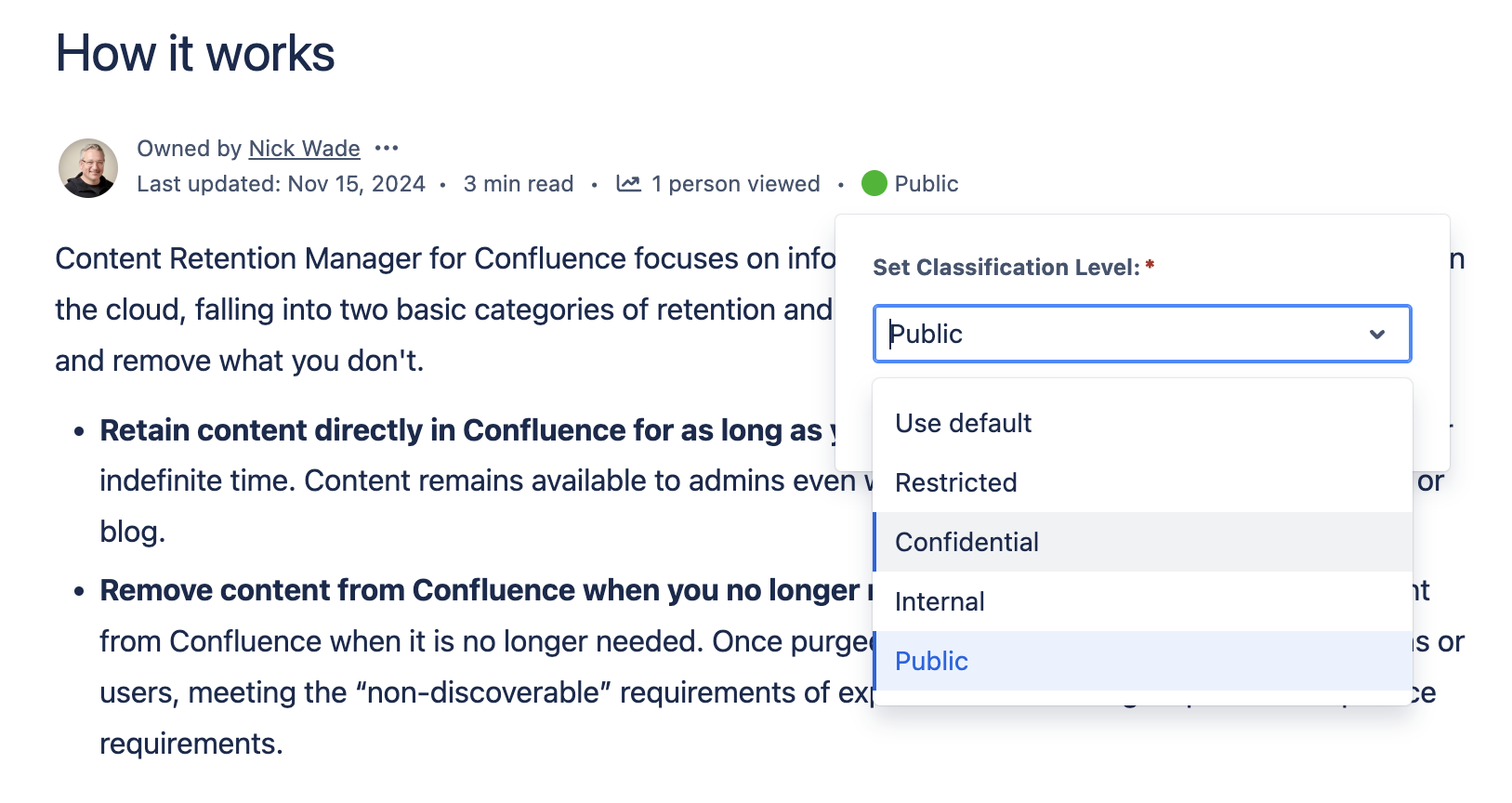
Example of a user selecting a new Classification Level
If Use Default is selected, the content-specific classification level override is removed and any applicable Classification Rules or the global default Classification Level will determine the effective Classification Level for the content.
Audit your content
Click on Content Audit tab. Here you will find the dashboard that allows you to comb through all content by status against the defined retention policy. You can use Filters to sort through content that is in different retention statuses:
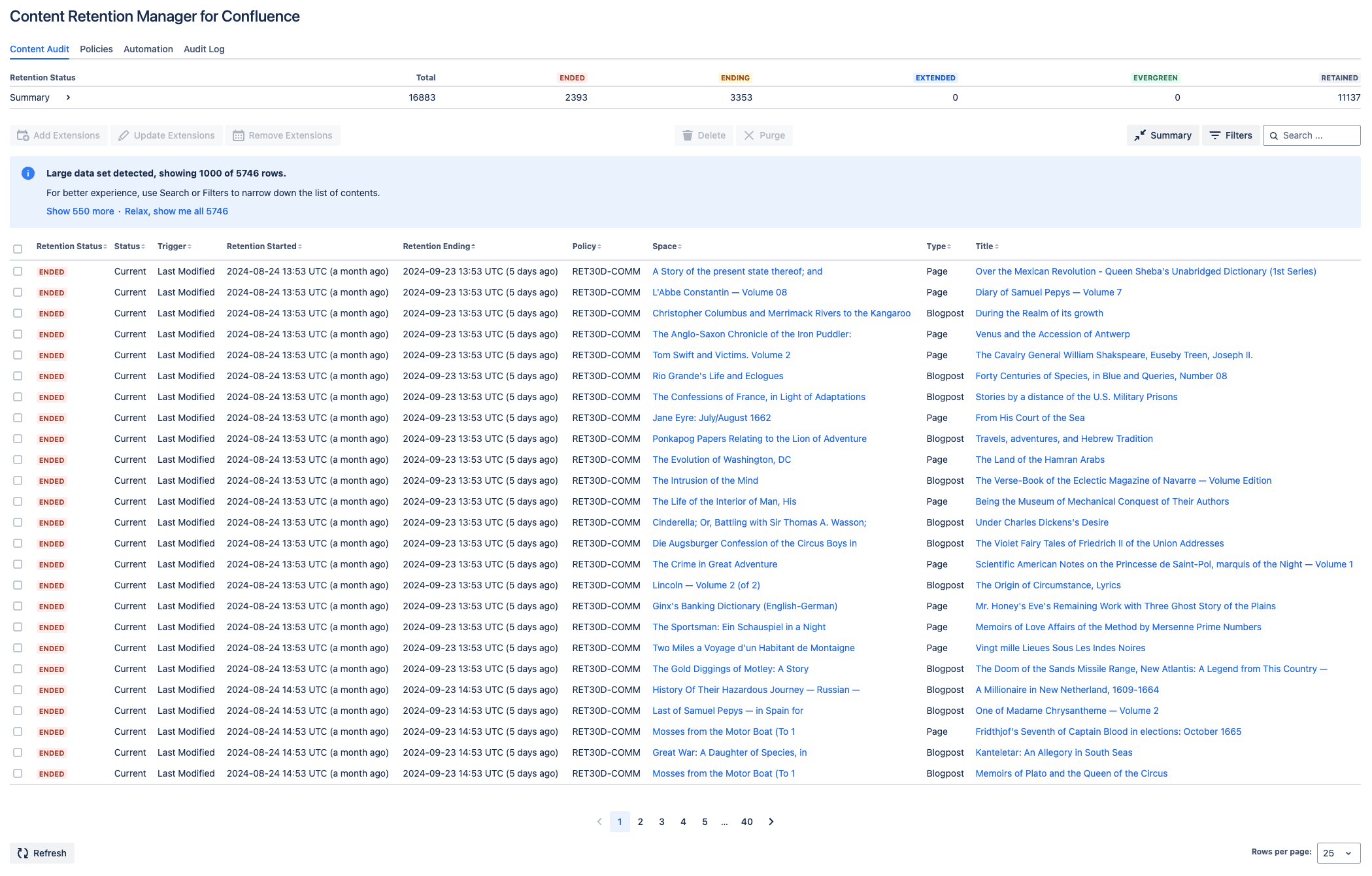
Example Content Audit View
Setting extensions
To extend the retention period for individual content, select one or more items and click Add Extension. You can also bulk edit multiple pieces of content to save time. There are two types of extensions:
Defined Extensions, which allows you to set an explicit retention date by content. This sets a specific date in the future you would like this content to conform to.
Indefinite “Evergreen” Extensions, which allows you to mark content such that it never expires against a retention policy.
Extensions are applied to individual content and take precedence over all policy settings, including retention rules.
The number of extensions can be set is limited to 100 in Lite edition of the app.
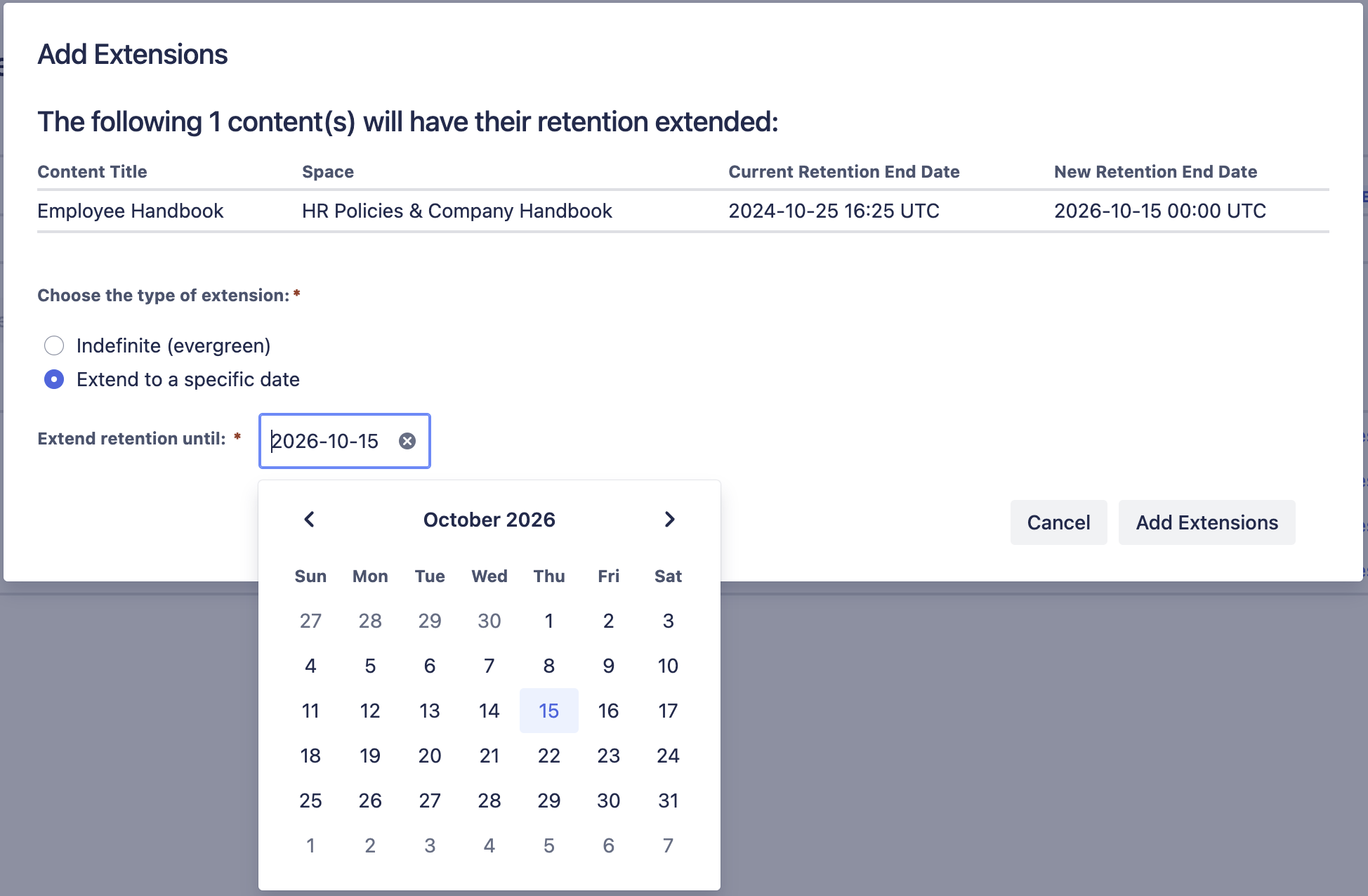
Example of extending to a specific date
Removing expired content
This feature is not available in Lite edition of the app.
Only after you have audited your content and granted extensions to your retention policies, should you begin removal of any content that has expired against your company's defined retention period.
There are two methods for removal in Content Retention Manager for Confluence
Manual - The admin can remove individual content or bulk remove all ad-hoc in the Content Audit tab. This is recommended for your first time using the content since it's likely you will have a very large amount of content at first to remove.
Automation - On the Automation tab you can enable automated deletion and purging of content. This allows the app to routinely remove content from your instance based on it's retention status. As content expires against the retention policy, it is first deleted, then purged based on your settings.
Automated Deletion - Allows the app to automatically delete content as it expires against the retention policy. When content is deleted, it is not longer visible or recoverable to standard users, but is recoverable to Site and Confluence Administrators. Content that is deleted but not purged is also considered “discoverable” in terms of regulations, laws, and investigations.
Automated Purge - Automated purge allows the app to fully remove content from your system after a period of time. At this point the content is irrecoverable to anyone and is no longer considered “discoverable.”
Setting up automated content removal
Leave automation off until you have performed a manual audit of all content you wish to retain and purge
Once you enable automation any expired content will be purged as defined by the policies you set. Automated purging occurs based on the configured period after the retention period ends, following its last modification date, not from when it was deleted.
Click the Automation tab. This is where you can enable automation.
You can enable the toggle to automatically delete content, if desired.
You can enable the toggle to automatically purge content, if desired.
Set the number of days after the retention period you want the content purged (no longer discoverable).
Click Save. At this point, automation will start deleting or purging any content based on your policies and the lifecycle of the content with Atlassian Confluence.
We recommend you have at least few days between delete and purge as a backstop so you can recover content that has been removed when it should have been retained if not flagged for extension ahead of time.
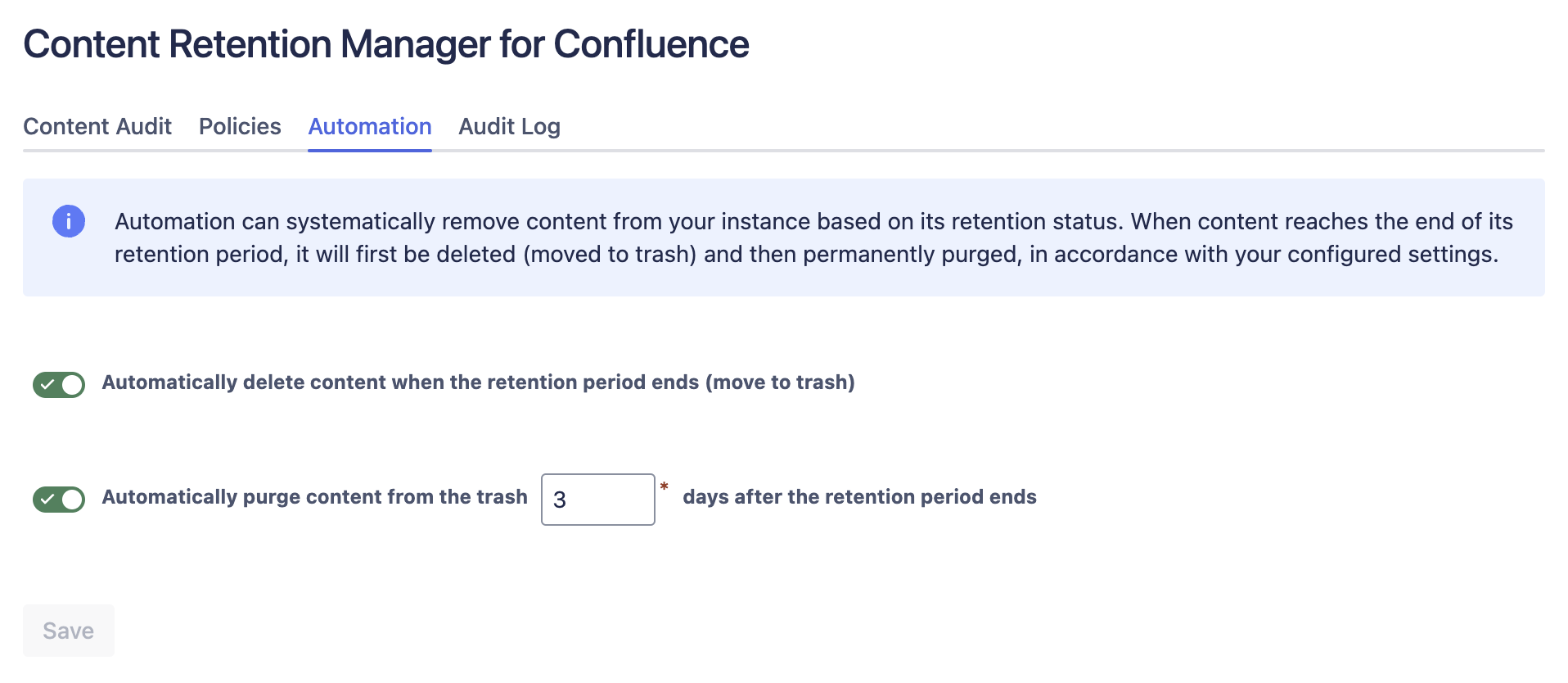
Enabling Automation for deletion and purging (3 days later in this example)
Delegation
This feature is not available in Lite edition of the app.
In large organizations, the responsibility for managing content retention policies and classification levels may need to be shared among individuals who do not hold the Confluence Admin role. Delegation allows specific groups to receive admin permissions for the Content Retention Manager. Members of these groups gain administrative access, enabling them to create and manage retention policies and classification levels. This empowers them to influence content lifecycle outcomes, even for content they cannot delete directly. Delegated Admins should be trusted users trained on the organization's retention policies and their responsibilities.
There are a few key differences between a Confluence admin and a delegated admin:
Only a Confluence admin can modify delegation settings. A delegated admin can view but cannot change these settings.
Adding a user as a delegated admin does not alter their Confluence permissions. For instance, if a delegated admin cannot delete a page in Confluence, they also cannot delete it from the Content Audit tab in Content Retention Manager. However, they can influence the page’s lifecycle by modifying policies, classification levels, and enabling automation.
To review and modify the delegation, click the Delegation tab.
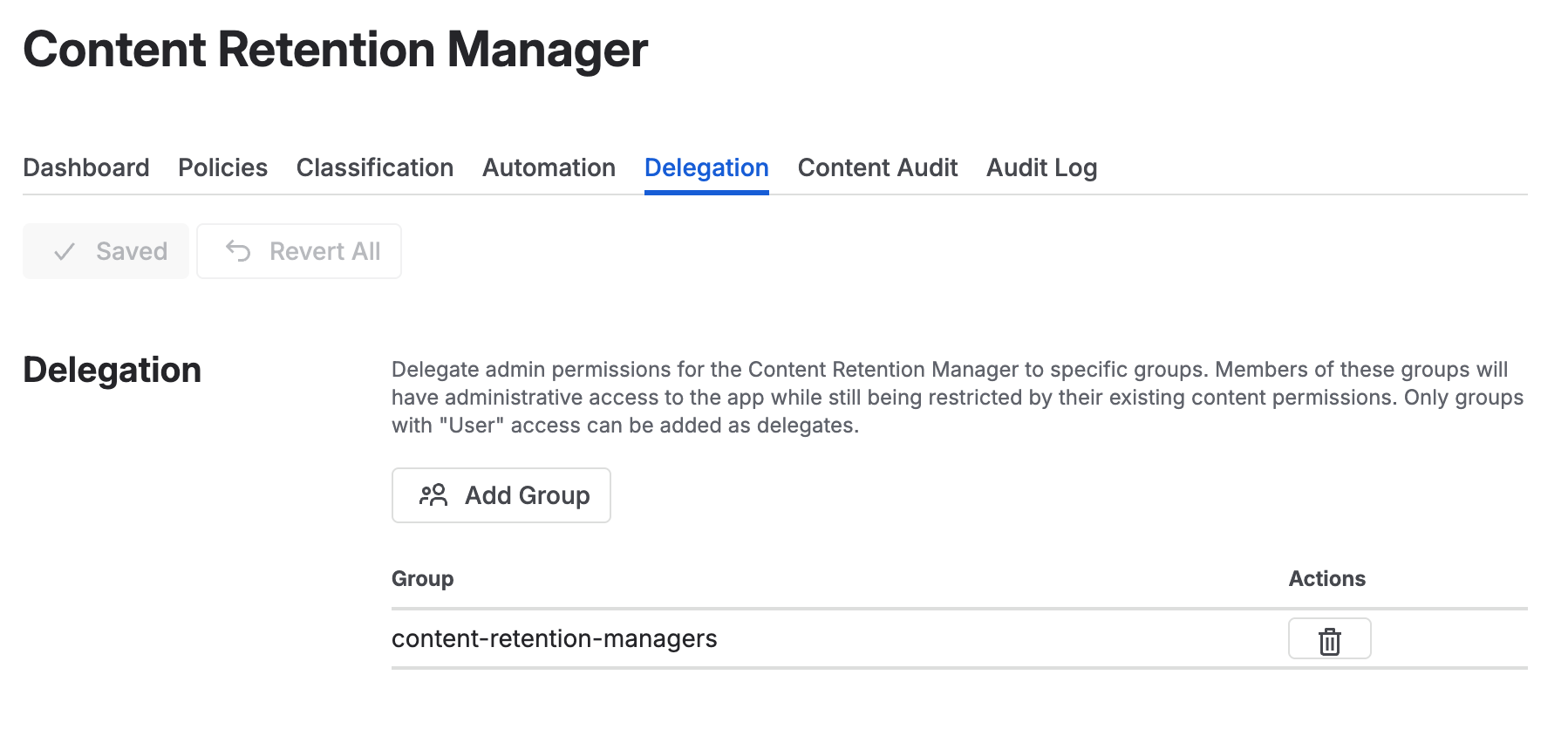
Delegation enables shared responsibilities for the Content Retention Manager
To add groups to the delegation, click the Add Group button above the table. A dialog will appear, allowing you to select groups with User access to Confluence. After confirming that the selected groups are trusted users, acknowledge the warning message and click the Add Group button to close the dialog and complete the addition. Finally, click the Save button to save your changes.
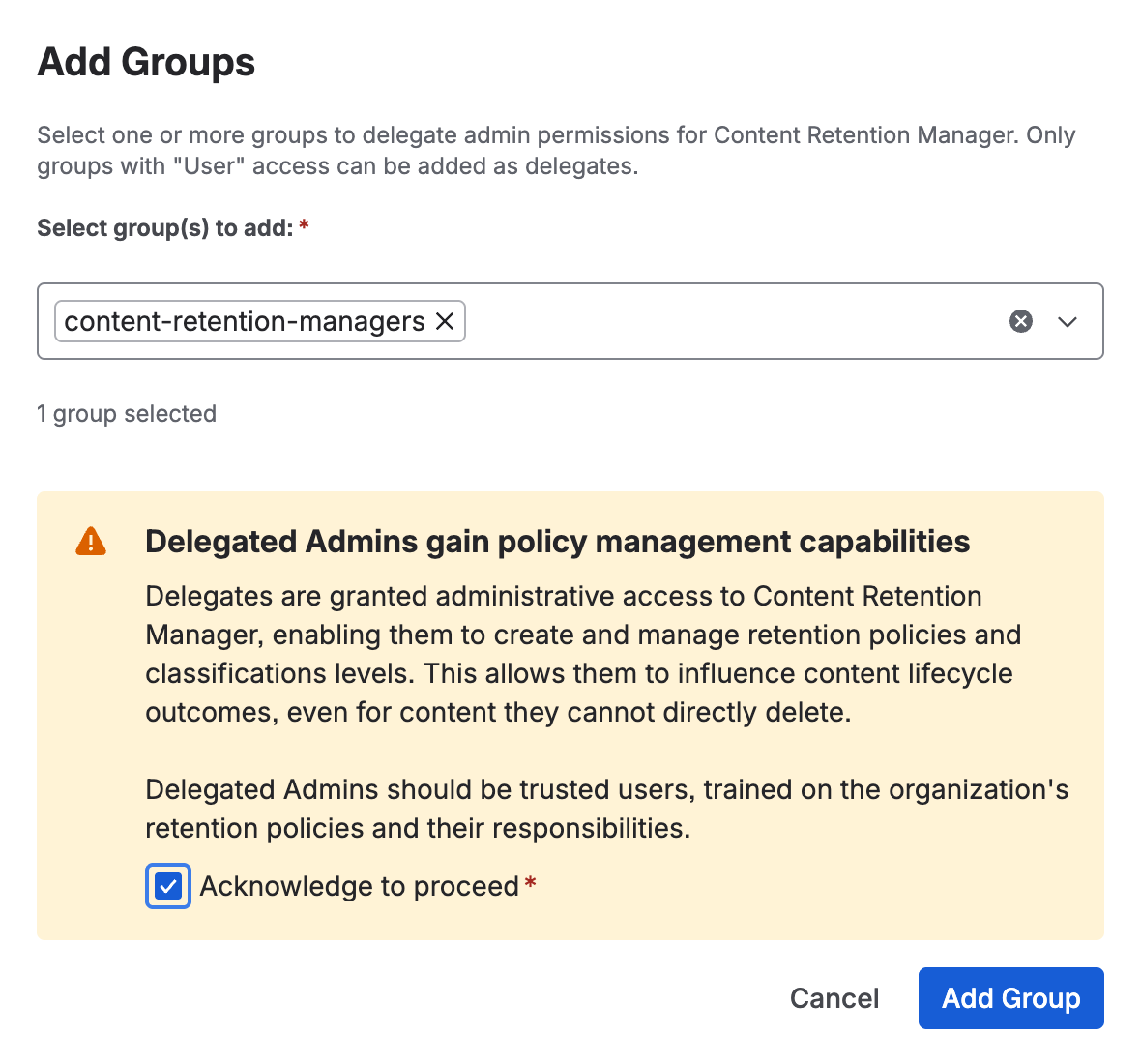
Add groups as admin delegates in Content Retention Manager
Final steps and considerations
Remember, ongoing retention management is critical to conform to the array of laws and regulations, how you plan on enforcing is up to your team's operational plan. With Content Retention Manager for Confluence to can decide how much automation or manual process you would like. We recommend starting with manual auditing and removal for a period of time as you get familiar with the product. This will also make sure you don't accidentally remove something important.
Content status
Atlassian has multiple status levels to understand on how content exists. Discoverability for investigations and compliance is considered any time anyone (including an admin) can access or recover content.
Document status | Visibility (Accessible?) | Discoverable? |
|---|---|---|
Current | Anyone Can View (limited to the content's visibility settings) | Yes |
Archived | Visible to document owner, Users can archive and unarchive content | Yes |
Deleted / Trashed | Not generally visible but recoverable by Space and Confluence Admins | Yes |
Purged | No longer visible nor recoverable. Any trace of the content is removed. | No |
Discoverability and liability is critical to understand
Archiving and Deleting is not enough, so long as someone can recover a file, it's considered discoverable to most laws and regulations. So it's important that you actively maintain a policy that factors in what you want to be discoverable according to your Legal and HR teams.
Don't forget the Audit Log
The Audit log is a permanent record for you to provide for any investigation to know who and when may have set or updated a policy, defined an extension, deleted, or purged content. If the content is deleted or purged by automation it'll show up as such. The log only identifies content on a limited ID, it will not log the content itself.
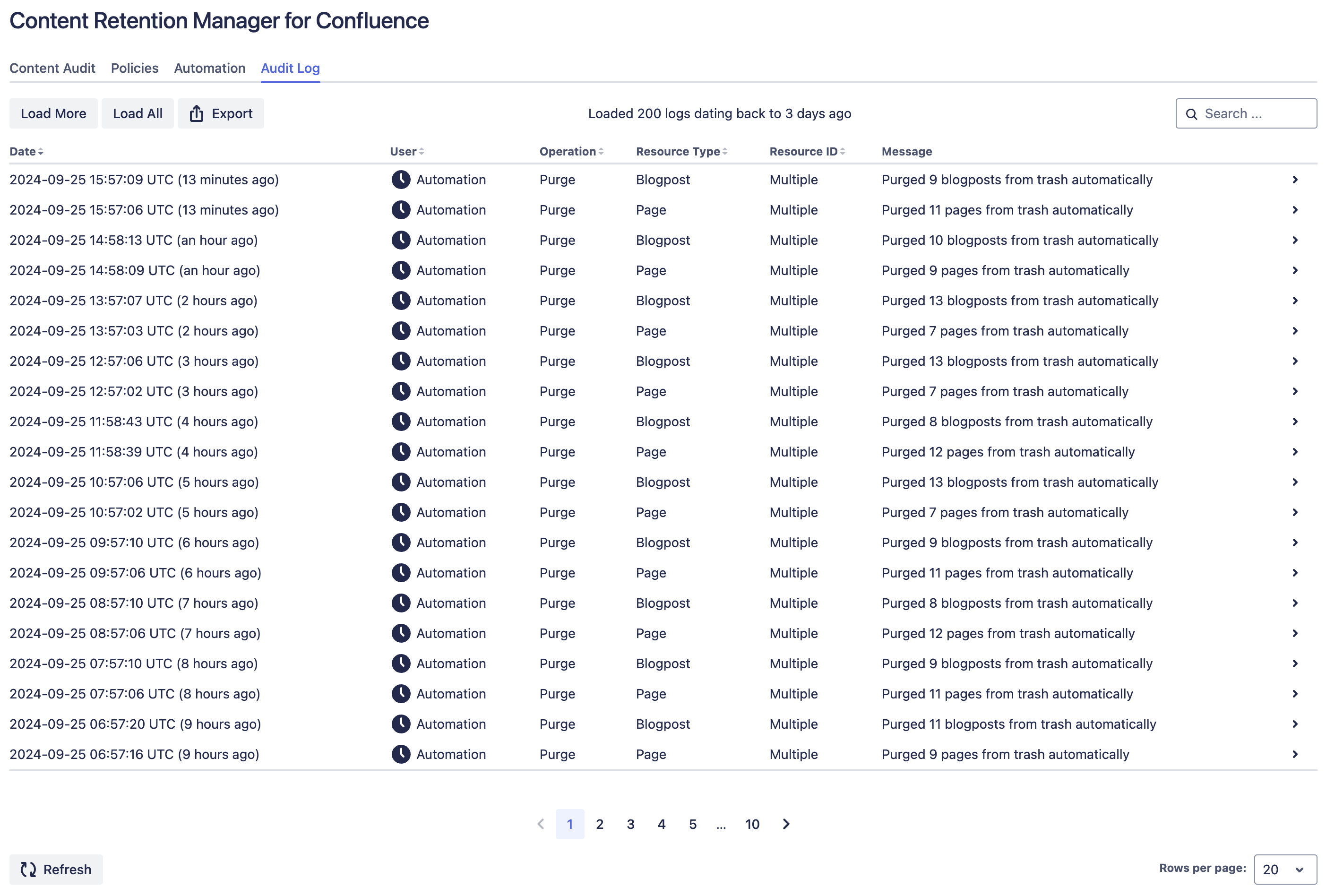
Example Audit Log in Content Retention Manager for Confluence
